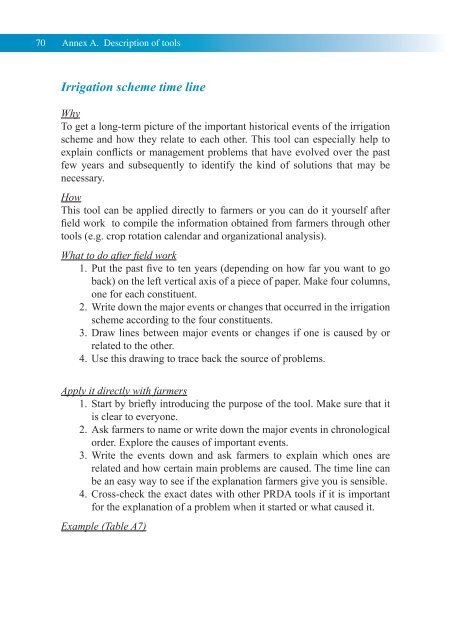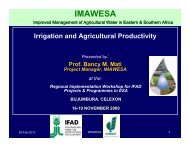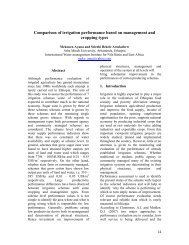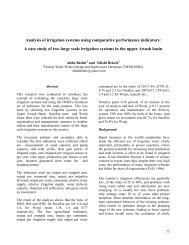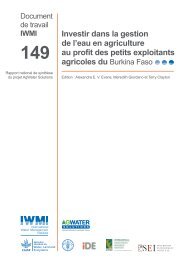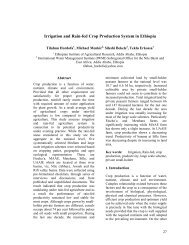- Page 1 and 2:
ManualParticipatory Rapid Diagnosis
- Page 5:
PRDA ManualiiiContentsForewordAvant
- Page 10 and 11:
viiiForwardcomme des organisations
- Page 12 and 13:
xAcknowledgementsIn Ethiopia• Dod
- Page 15 and 16:
PRDA ManualxiiiAcronymsACCORDACSIAI
- Page 18 and 19:
2 Chapter 1. Introduction• change
- Page 21 and 22:
PRDA Manual 5Chapter 2Overview of p
- Page 23 and 24:
PRDA Manual 71C - Collect secondary
- Page 25 and 26:
PRDA Manual 9Based on the selected
- Page 27 and 28:
PRDA Manual 11Chapter 3Constitutent
- Page 29 and 30:
PRDA Manual 13Water resource and ab
- Page 31 and 32:
PRDA Manual 15Agricultural outputs:
- Page 33 and 34:
PRDA Manual 17supply and marketing
- Page 35 and 36: PRDA Manual 19of irrigation organiz
- Page 37 and 38: PRDA Manual 21unit of land, meaning
- Page 39 and 40: PRDA Manual 23the irrigated scheme
- Page 41 and 42: PRDA Manual 25• comparing recomme
- Page 43 and 44: PRDA Manual 27Chapter 4Planning the
- Page 45 and 46: PRDA Manual 29• key informants su
- Page 47 and 48: PRDA Manual 31Table 1. Recommended
- Page 49 and 50: PRDA Manual 33Walk” from intake t
- Page 51 and 52: PRDA Manual 35Chapter 5Using PRDA T
- Page 53 and 54: PRDA Manual 37What to record?• Th
- Page 55 and 56: PRDA Manual 39• Purposive samplin
- Page 57: PRDA Manual 41Table 3. Examples of
- Page 60 and 61: 44ReferencesInformation sources per
- Page 62 and 63: 46 Annex A. Description of toolsSte
- Page 64 and 65: 48 Annex A. Description of toolsSta
- Page 66 and 67: 50 Annex A. Description of toolsBox
- Page 68 and 69: 52 Annex A. Description of toolsspe
- Page 70 and 71: 54 Annex A. Description of toolsBox
- Page 72 and 73: 56 Annex A. Description of toolsPlo
- Page 74 and 75: 58 Annex A. Description of toolsOn
- Page 76 and 77: 60 Annex A. Description of toolsBox
- Page 78 and 79: 62 Annex A. Description of toolsFig
- Page 80 and 81: 64 Annex A. Description of toolsWat
- Page 82 and 83: 66 Annex A. Description of toolsTab
- Page 84 and 85: 68 Annex A. Description of toolsFig
- Page 88 and 89: 72 Annex A. Description of toolsHis
- Page 90 and 91: 74 Annex A. Description of toolsExa
- Page 92 and 93: 76 Annex A. Description of toolsVen
- Page 94 and 95: 78 Annex A. Description of toolsBox
- Page 96 and 97: 80 Annex A. Description of toolsTas
- Page 98 and 99: 82 Annex A. Description of toolsHow
- Page 100 and 101: 84 Annex A. Description of toolsBox
- Page 102 and 103: 86 Annex A. Description of toolsRap
- Page 104 and 105: 88 Annex A. Description of toolsBox
- Page 106 and 107: 90 Annex A. Description of toolsFig
- Page 108 and 109: 92 Annex A. Description of toolsTab
- Page 110 and 111: 94 Annex A. Description of toolsIf
- Page 112 and 113: 96 Annex A. Description of toolsTab
- Page 114 and 115: 98 Annex A. Description of tools4.
- Page 116 and 117: 100 Annex A. Description of toolsLi
- Page 118 and 119: 102 Annex A. Description of toolsSo
- Page 120 and 121: 104 Annex A. Description of toolsBo
- Page 122 and 123: 106 Annex A. Description of toolsTa
- Page 124 and 125: 108 Annex A. Description of toolsTa
- Page 126 and 127: 110 Annex A. Description of toolsTa
- Page 128 and 129: 112 Annex B. Reporting sheetsPresen
- Page 130 and 131: 114 Annex B. Reporting sheetsSHEET
- Page 132 and 133: 116 Annex B. Reporting sheetsSHEET
- Page 134 and 135: 118 Annex B. Reporting sheets2. Plo
- Page 136 and 137:
120 Annex B. Reporting sheetsName o
- Page 138 and 139:
122 Annex B. Reporting sheetsPRDA M
- Page 140 and 141:
124 Annex B. Reporting sheetsPRDA M
- Page 142 and 143:
126 Annex B. Reporting sheetsPRDA M
- Page 144 and 145:
128 Annex B. Reporting sheetsPRDA M
- Page 146 and 147:
130 Annex B. Reporting sheetsPRDA M
- Page 148 and 149:
132 Annex B. Reporting sheetsPU16PR
- Page 150 and 151:
134 Annex B. Reporting sheetsPRDA M
- Page 152 and 153:
136 Annex B. Reporting sheetsPRDA M
- Page 154 and 155:
138 Annex B. Reporting sheetsPRDA M
- Page 156 and 157:
140 Annex B. Reporting sheetsPRDA M
- Page 158 and 159:
142 Annex B. Reporting sheetsPRDA M
- Page 160 and 161:
144 Annex B. Reporting sheetsPRDA M
- Page 162 and 163:
146 Annex B. Reporting sheetsPRDA M
- Page 164 and 165:
148 Annex B. Reporting sheetsPRDA M
- Page 166 and 167:
150 Annex B. Reporting sheetsPRDA M
- Page 168 and 169:
152 Annex B. Reporting sheetsPRDA M
- Page 170 and 171:
154 Annex B. Reporting sheetsPRDA M
- Page 172 and 173:
156 Annex B. Reporting sheetsPRDA M
- Page 174 and 175:
158 Annex B. Reporting sheetsPRDA M
- Page 176 and 177:
160 Annex C. Brief presentation of
- Page 178 and 179:
162 Annex C. Brief presentation of
- Page 180 and 181:
164 Annex C. Brief presentation of
- Page 182 and 183:
166 Annex C. Brief presentation of
- Page 184 and 185:
168 Annex C. Brief presentation of


